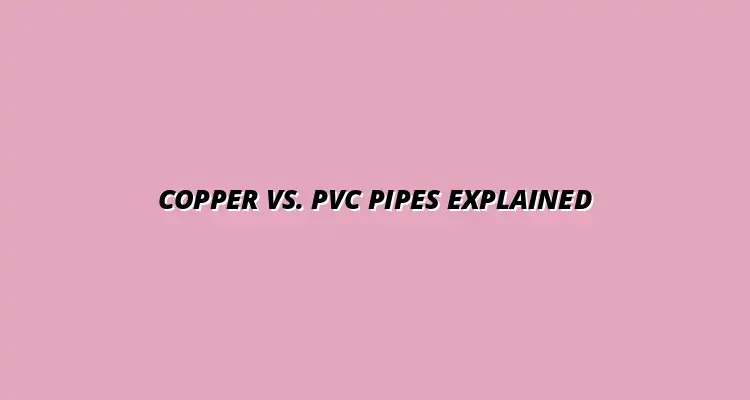
- Beginner Tips
- Jan 31
2025-02-17
Copper pipes are a popular choice in plumbing due to their durability and corrosion resistance. Made primarily from copper, these pipes are known for their ability to withstand high temperatures and pressures. The material's natural properties help inhibit the growth of harmful bacteria, making it a safe option for drinking water.
There are two main types of copper pipes: Type K, which is thickest and used for underground applications, and Type L, ideal for indoor plumbing. The versatility of copper pipes makes them suitable for both residential and commercial installations. Plus, they can be easily soldered together, which provides a strong, leak-proof connection. Choosing the right pipe material for your home is crucial; learn more about this process by reading this helpful guide on choosing pipe material.
In plumbing systems, copper pipes are often used for various applications, including:
These applications showcase copper's strength and reliability, making it a go-to material for many plumbing professionals. Moreover, copper pipes are less prone to bursting in extreme temperatures, which adds to their appeal!
PVC, or polyvinyl chloride, pipes are another commonly used material in plumbing. Known for their lightweight and cost-effective nature, PVC pipes are easy to handle and install. They are resistant to corrosion and chemicals, making them a suitable option for various plumbing projects. Understanding pipe fittings is also essential for successful plumbing installations.
One of the standout features of PVC pipes is their ability to insulate against sound. This means they can minimize noise from water flow, making them a quiet option for both residential and commercial spaces. Additionally, their smooth interior surface reduces friction, which can improve water flow efficiency.
PVC pipes are widely used for different plumbing applications, such as:
These uses highlight the adaptability of PVC pipes in plumbing systems, making them a popular choice for homeowners and contractors alike. Their ease of installation and lower price point can also lead to significant savings, which is a major advantage!
When it comes to plumbing materials, considering the environmental impact is crucial. Both copper and PVC pipes have their unique characteristics that affect their sustainability. Understanding these differences helps homeowners and contractors make informed decisions that align with eco-friendly practices. For example, learning to fix a leaky faucet can significantly reduce water waste.
In this section, we will delve into the environmental implications of using copper and PVC in plumbing systems. From recyclability to energy consumption, we'll explore how each material stacks up against the other in terms of sustainability.
Copper pipes are often regarded as a more environmentally friendly option, primarily due to their recyclability. Copper can be recycled multiple times without losing its quality, making it a sustainable choice for plumbing. When it reaches the end of its life, copper can be repurposed into new products, which significantly reduces waste. Durable materials are key for long-lasting kitchen plumbing; discover more about them here.
Moreover, the extraction process for copper has improved over the years, with many companies adopting practices that minimize environmental impact. This includes reducing harmful emissions and implementing more efficient mining techniques.
One of the standout features of copper is its high level of recyclability. Nearly 80% of the copper mined in history is still in use today. This impressive recycling rate means that the demand for new copper extraction is significantly lower. Furthermore, recycled copper requires less energy to process compared to new copper, which benefits the environment.
Additionally, copper has natural antimicrobial properties, which can improve water quality and reduce the growth of harmful bacteria. This characteristic enhances its overall environmental impact, making it a preferable option in many contexts.
When we look at the energy consumption involved in manufacturing, copper pipes often require more energy initially compared to PVC. However, once installed, their durability can lower the total energy footprint over the long term. It's essential to weigh these factors to determine which material aligns best with sustainable practices. Regular maintenance, such as preventing water heater leaks, can further enhance sustainability. Find helpful tips here.
In general, the manufacturing process for copper is more energy-intensive than that of PVC. However, the long lifespan of copper could make it the more sustainable choice in certain situations.
PVC pipes have gained popularity in plumbing due to their affordability and ease of installation. However, their environmental sustainability is a bit more complicated. While PVC is lightweight and uses less energy to transport, its production and disposal raise several concerns. Sometimes, DIY projects can help, such as replacing your bathroom sink faucet. Check out this guide for help: Replace your bathroom sink faucet.
Understanding the challenges associated with PVC is vital for anyone considering this material for plumbing projects. Let's take a closer look at both the pros and cons of using PVC in plumbing.
One of the main challenges with PVC is its disposal. Unlike copper, which can be easily recycled, PVC poses significant hurdles when it comes to recycling. The process to recycle PVC is complicated and often not economically viable. This can lead to PVC pipes ending up in landfills, contributing to long-term environmental issues.
Additionally, the additives used in PVC production can leach into the environment, raising concerns about potential health risks and pollution. Homeowners need to be aware of these challenges when considering PVC for their plumbing needs. For plumbing emergencies in Billesley, Birmingham, you can find help here.
In response to the environmental challenges posed by PVC, various regulations have been introduced to mitigate the impact of its production. These regulations aim to reduce harmful emissions and promote safer manufacturing processes. Keeping an eye on these regulations can help homeowners and contractors make more sustainable choices when it comes to plumbing materials.
Overall, while PVC has some benefits, the environmental concerns surrounding its production and disposal cannot be overlooked. It's essential to weigh these factors against the advantages of copper to determine the right choice for your plumbing project.
